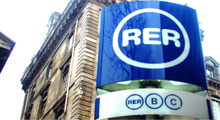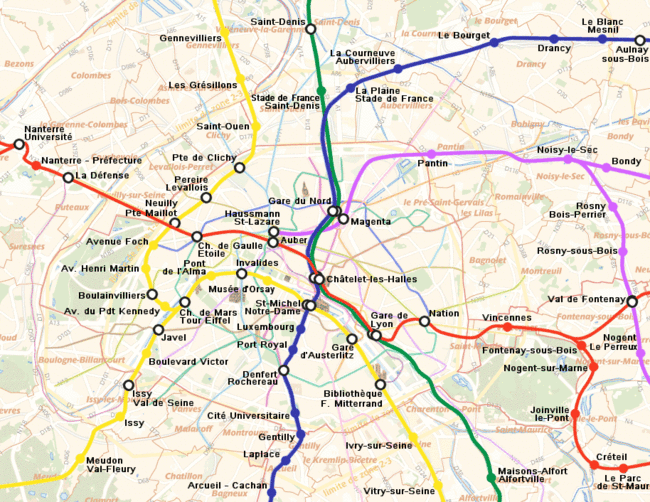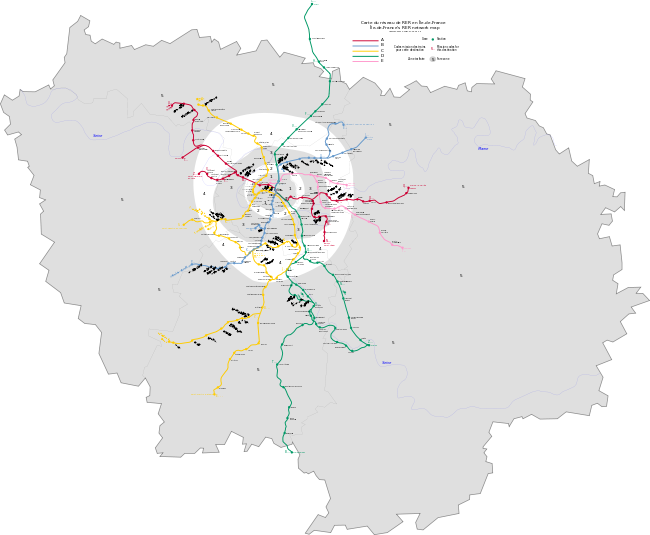
RER
Did you know...
This content from Wikipedia has been selected by SOS Children for suitability in schools around the world. Sponsoring children helps children in the developing world to learn too.
The RER (French pronunciation: [ɛʁəɛʁ]; French: Réseau Express Régional, "Regional Express Network") is a rapid transit system in France serving Paris and its suburbs. The RER is an integration of a modern city-centre underground rail and a pre-existing set of commuter rail lines. It has several connections with the Paris Métro within the city of Paris. Within the city, the RER functions like the Métro, but is faster as it has fewer stops. Since 1999 the network has consisted of five lines: A, B, C, D and E. The RER is still expanding: Line E, which opened in 1999, is planned for westward extension by 2020.
Characteristics
The RER contains 257 stations, 33 of which are within the city of Paris, and runs over 587 km (365 mi) of track, including 76.5 km (47.5 mi) underground. Each line passes through the city almost exclusively underground and on dedicated tracks. The RER is operated partly by RATP, the transport authority that operates Paris Métro, and partly by SNCF, the national rail operator. In spite of this, the system uses a single fare structure and no transfer is needed between parts run by the two operators. Total traffic on the central sections of lines A and B, operated by RATP, was 452 million in 2006; in the same year, total traffic on all lines operated by SNCF (both RER and Transilien trains) was 657 million.
RATP manages 65 RER stations, including all stations on Line A east of Nanterre-Préfecture and those on the branch to Saint-Germain-en-Laye. It also operates stations on Line B South of Gare du Nord. Other stations on the two lines and those on lines C, D and E are operated by SNCF. Of the RER stations operated by RATP, 9 have interchanges with Métro lines, and 9 allow transfer to SNCF's Transilien service.
History
Origins
The origins of the RER can be traced back to the 1936 Ruhlmann- Langewin plan of the Compagnie du chemin de fer métropolitain de Paris (Metropolitan Railway Company of Paris) for a "métropolitain express" (express metro). The company's post-war successor, RATP, revived the scheme in the 1950s, and in 1960 an interministerial committee decided to go ahead with the construction of an east-west line. Subsequently, the central part of the RER was completed in a large-scale civil engineering project between 1962 and 1977 and chief supervisor of the project was Siavash Teimouri. As its instigator, RATP was granted authority to run the new link. The embryonic (and as yet unnamed) RER was not properly conceived until the 1965 Schéma directeur d'aménagement et d'urbanisme, which designed an H-shaped network with two north-south routes. Only a single north-south link crossing the Left Bank has so far come to fruition, although Paris Métro's Line 13 has been extended to perform a similar function. Between 1969 and 1970, RATP purchased the Vincennes and Saint-Germain lines from SNCF.
First phase
In the first phase of construction, the Vincennes and Saint-Germain lines became the ends of the east-west Line A, the central section of which was opened station by station between 1969 and 1977. On its completion, Line A was joined by the initial southern section of the north-south Line B. During this first phase, six new stations were built, three of which are entirely underground.
Construction was inaugurated by Robert Buron, then Minister for Public Works, at the Pont de Neuilly on 6 July 1961, four years before the publication of the official network blueprint. The rapid expansion of the La Défense business district in the west made the western section of the first line a priority. Nation, the first new station, was opened on 12 December 1969 and temporarily became the new western terminus of the Vincennes line. The section from Étoile (not yet renamed after Charles de Gaulle) to La Défense was opened a few weeks later. It was subsequently extended eastward to the newly-built Auber station on 23 November 1971, and westward to Saint-Germain-en-Laye on 1 October 1972. The latter extension was achieved by a connection to the existing Saint-Germain-en-Laye line, the oldest railway line into Paris, at Nanterre.
The RER network came into being on 9 December 1977 with the joining of the eastern Nation- Boissy segment and the western Auber- Saint-Germain-en-Laye segment at Châtelet – Les Halles. The southern Ligne de Sceaux was simultaneously extended from Luxembourg to meet Line A at Châtelet – Les Halles, becoming the new Line B. The system of line letters was introduced to the public on this occasion, though it had been used internally by RATP and SNCF for some time.
Completion
A second phase, from the end of the 1970s, was carried out more slowly. SNCF gained the authorisation to operate its own routes, which became lines C, D and E. Extensive sections of suburban tracks were added to the network, but only four new stations were built. In this time period, the network was completed in the following stages:
- Line C (along the Left Bank of the Seine) was added in 1979, involving the construction of a link between Invalides and Musée d'Orsay.
- Line B was extended to Gare du Nord in 1981 with a new deep tunnel from Châtelet – Les Halles. It was subsequently extended further northward.
- Line D (north to south-east via Châtelet – Les Halles) was completed in 1995 with the construction of a deep tunnel between Châtelet – Les Halles and Gare de Lyon. No new building work was necessary at Châtelet – Les Halles, as additional platforms for Line D had been built at the time of the station's construction 20 years earlier.
- Line E was added in 1999, connecting the north-east with Gare Saint-Lazare by means of a new deep tunnel from Gare de l'Est.
Finance
The RER's first phase of construction during the 1960s and 1970s was marked by scale and expense. In 1973 alone, FRF 2 billion were committed to the project in the budget. This equates to roughly € 1.37 billion in 2005 terms, and closer to double that as a proportion of the region's (then much smaller) economic output. This and subsequent spending was partly sustained by the versement transport, a local tax levied on businesses. The tax was introduced in July 1971 and remains in effect.
Maps
Trains
The predominance of suburban SNCF track on the RER network explains why RER trains use overhead line power and run on the left, like SNCF trains (except in Alsace-Moselle), contrary to the Métro where trains use third rail power and run on the right. RER trains run by the two different operators share the same track infrastructure, a practice called interconnection. On the RER, interconnection required the development of specific trains (MI 79 series for Materiel d'Interconnexion 1979, and MI 2N series for Materiel d'Interconnexion à 2 niveaux (double-deck interconnection stock)) capable of operating under both 1.5 kV direct current on the RATP network and 25 kV / 50 Hz alternating current on the SNCF network. The MS 61 series (Matériel Suburbain 1961) can be used only on the 1.5 kV DC network.
The RER's tunnels have unusually large cross-sections. This is due to a 1961 decision to build according to a standard set by the Union Internationale des Chemins de Fer, with space for overhead catenary power supply to trains. Single-track tunnels measure 6.30 m across and double-track tunnels up to 8.70 m, meaning a cross-sectional area of up to 50 square metres, larger than that of the stations on many comparable underground rail networks.
The first RER rolling stock in fact predated the formation of the RER by 40 years, with the Z 23000 stock used on the ligne de Sceaux (which was subsequently integrated into RER B) from 1937 until February 27, 1987. In 1965 the Z 5300 train was introduced, followed by the MS 61 in 1967 (refurbished 1985-1987 and 2006-2009), MS 79 in 1980, MS 84 and Z 8800 in 1985, Z 20500 in 1998, MI 2N in 1996, Z 20900 in 2001 and MI 09 on December 5, 2011.
Lines
| Line name | Opened | Last extension |
Stations served |
Length | Average Interstation |
Journeys made (per annum) |
|
|---|---|---|---|---|---|---|---|
| |
Line A | 1977 | 1994 | 46 | 108.5 km / 67.5 miles | 2,411 m | 272,800,000 |
| |
Line B | 1977 | 1981 | 47 | 80.0 km / 49.8 miles | 1,739 m | 165,100,000 |
| |
Line C | 1979 | 2000 | 84 | 185.6 km / 115.5 miles | 2,184 m | 140,000,000 |
| |
Line D | 1987 | 1995 | 59 | 190.0 km / 118.1 miles | 2,807 m | 145,000,000 |
| |
Line E | 1999 | 2003 | 21 | 52.3 km / 32.5 miles | 2,615 m | 60,000,000 |
Stations
Ten new stations have been built under the heart of Paris since the 1960s as part of the RER project. The six stations of Line A opened between 1969 and 1977 are:
- Nation (1969): deep construction at the Place de la Nation.
- Charles de Gaulle - Étoile (1970): deep construction at the Arc de Triomphe.
- La Défense (1970): near-surface construction beneath the site of the yet-to-be-built Grande Arche de la Défense, just outside the Paris city boundary.
- Auber (1971): deep construction near Gare Saint-Lazare; once claimed to be the largest underground station in the world.
- Châtelet - Les Halles (1977): near-surface construction on the site of the former marketplace, today claimed to be the largest underground station in the world.
- Gare de Lyon (1977): near-surface construction beneath and alongside the main-line SNCF station.
Some controversy followed the construction of the Line A. Using the model of the existing Métro, and unlike any other underground network in the world, engineers elected to build the three new deep stations ( Étoile, Auber and Nation) as single monolithic halls with lateral platforms and no supporting pillars. A hybrid solution of adjacent halls was rejected on the grounds that it "completely sacrificed the architectural aspect" of the oeuvre. The scale in question was vast: the new stations cathédrales were up to three times longer, wider and taller than Métro stations, and hence 20 or 30 times more voluminous. Most importantly, unlike the Métro they were to be constructed deep underground. The decision turned out to be expensive: around 8 billion francs for the three stations, equivalent to € 1.2 billion in 2005 terms, with the two-level Auber the costliest of the three. The comparison was obvious and unfavourable with London's Victoria Line, a deep line of 22 km constructed during the same period using a two-tunnel approach at vastly lower cost. However, the three stations represent undeniable engineering feats and are noticeably less claustrophobic than traditional underground stations.
Only two stations were inaugurated to complete Lines B, C and D:
- Gare du Nord (1982): near-surface construction on two levels.
- St-Michel - Notre-Dame (1988): deep construction on an existing stretch of the Line B between Luxembourg and Châtelet - Les Halles with two tunnels, common in other underground systems but unique in Paris. The station is situated on and built at the same time as the Luxembourg Châtelet tunnel.
Two stations were added to the network as part of Line E in the 1990s. They are notable for their lavishly spacious deep construction, a technique not used since Auber. Although similar to the three 1960s "cathedral stations" of Line A, their passenger traffic has so far proved vastly lower.
- Magenta (1999): deep construction serving both Gare du Nord and Gare de l'Est.
- Haussmann - Saint-Lazare (1999): deep construction serving Gare Saint-Lazare and Auber.
Usage
Journey times, particularly on east-west and north-south routes, have been cut spectacularly by the RER (and thanks to the cross-platform connection at Châtelet - Les Halles, even certain "diagonal" trips are rapid). As a result, the network has been an extraordinary popular success since its opening.
Lines A and B reached saturation relatively quickly, exceeding by far all traffic expectations: up to 55,000 passengers per hour in each direction on Line A, the highest such figure in the world outside of East Asia. Despite a frequency of more than one train every two minutes, made possible by the installation of digital signalling in 1989, and the partial introduction of double-decker trains since 1998, the central stations of Line A are critically crowded at peak times.
Used for leisure journeys, the RER has had a major social impact. By bringing far-flung suburbs within easy reach of central Paris, the network has aided the reintegration of the traditionally insular capital with its periphery. The evidence of this social impact can be seen at Châtelet - Les Halles, whose neighbourhood and Forum des Halles leisure and shopping facilities are popular among banlieusards, in particular from eastern suburbs.
Future developments
Extensions to the RER focus on Line E, which ends at Haussmann - Saint-Lazare, serving only one side of Paris, unlike all other RER lines. Various Line E extensions have been proposed:
- westward from Haussmann - St Lazare to Mantes-la-Jolie. Plans for this extension include an eight kilometer bored tunnel from the current western terminus at Haussmann - St Lazare, with new stations at Porte Maillot, La Défense, and Nanterre - La Folie, and a connection to the SNCF Normandy line in or near Nanterre, the transfer of the current Line A Poissy service to Line E, and its further extension down the Seine valley to Mantes.
- eastward from Chelles-Gournay to Esbly and Meaux
- eastward from Tournan to Coulommiers
Until the western section is in service, neither of the eastern extensions can be put into service, because the Haussmann - St Lazare station is currently at its maximum capacity because all trains are currently forced to turn around at this station. Once the western extension is in service, Haussmann - St Lazare will become a through station and the eastern extensions will be possible. One of the primary reasons for the completion of Line E through Paris is to relieve Line A of its excessive ridership, especially at commute times. Plans for the westward extension are in an advanced stage and construction is to begin in 2013, with an inauguration of the new line in 2020.
A new Line E station has been proposed at Rue de l'Évangile (now to be called Rosa Parks) on the approach to Gare de l'Est, with a tentative opening date of 2014.
Older plans existed for a line F, which would connect Argenteuil to Rambouillet via existing tracks of the Saint-Lazare and Montparnasse rail networks. A new tunnel would be bored below Paris, with the creation of a station at Invalides. The cost of the new tunnel and the fact that Saint-Lazare and Montparnasse networks form a loop make this project unlikely to happen.
Miscellany
The RER has received criticism for its high level of particle pollution during busy periods, essentially due to train braking. Pollution by PM10 particles regularly reaches 400 µg/m3 at Auber, substantially more than at neighboring metro stations and eight times the EU Commission's daily average limit of 50 µg/m3.





















